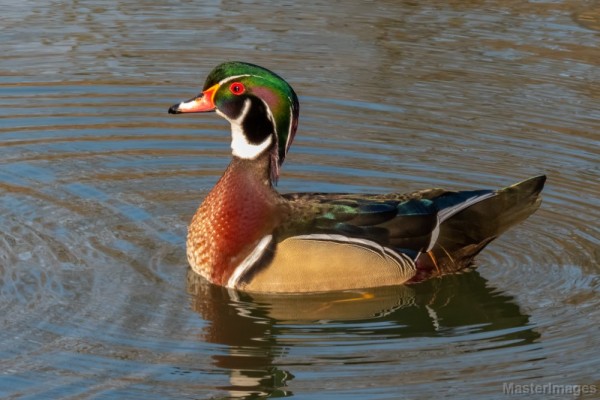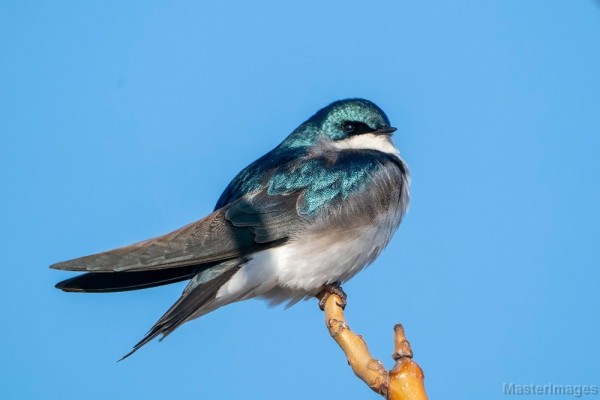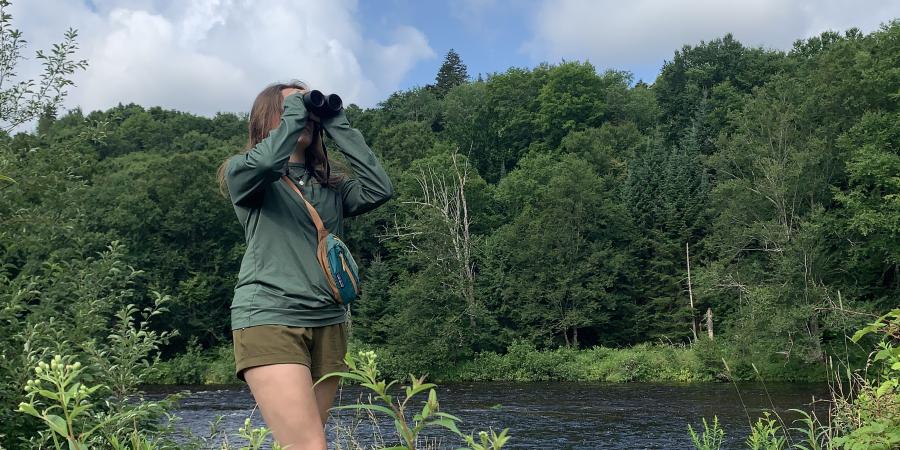Early mornings on the river are peaceful. When walking along the river with steam rising off the water, sometimes the only noise you can hear is the singing of birds above in their branches. Rivers are important for many species of birds, providing sources of water, shelter, food, and breeding habitat. In the spring and summer, birds migrate from all over the world to the Ausable River where they breed and raise their young, which makes for exciting birding opportunities.
Birding is an accessible activity for anyone interested in learning about local wildlife. Along the Ausable, there are many places to look for birds – you can even bird from the comfort of your car! There are several pull-offs along the bank of the river, particularly along the West Branch, that offer vantage points to spot waterfowl, songbirds, raptors, and more. There are also hiking trails near the river that lead to beautiful birding spots, including Copperas Pond and Owen Pond.
Throughout my time as the River Steward this summer, I've been able to spend some downtime looking for and listening to the birds, especially in the early morning. Here are some of the most common, which are also my personal favorite, species I've encountered:
Wood Duck
The wood duck is a shy, flighty species of waterfowl. The males are striking, with a chestnut-colored breast, green head, bold markings, and crested head. The females are brown with distinct white eye rings. They are typically found along wetlands, ponds, and rivers that are forested with relatively dense vegetation that the duck hides in and feeds on. Wood ducks favor feeding on aquatic plants, such as water lilies, smartweed, and duckweed. Unlike other ducks, they have strong, grippy feet that allow them to perch on the branches of trees near water. One particularly sunny morning, I was lucky enough to spot a drake (male), hen (female), and four ducklings perusing around yellow pond lilies as I peeked from behind the shrubs.

Male wood duck.
Belted Kingfisher
This unique bird lives up to its name. It's commonly seen perching above the water, scanning the surface, waiting to dive and catch a fish. These birds are blue-gray with white necks and bellies and appear to be top-heavy. Females have a chestnut band, or belt, across their bellies. They have a piercing, rattling call that is easy to identify. On multiple occasions, I've seen them perched on telephone wires that extend over the river, and watched them dive for fish.

Female belted kingfisher.
Cedar Waxwing
This common backyard bird is brown-yellow with a black mask and noticeable red dashes on its wings. They are one of the few North American birds that rely heavily on fruit as a main staple of their diet. Insects are also part of their diet, and it’s not unusual for them to be seen darting over the river to catch flying insects. Cedar waxwings are almost always found in groups and sometimes will form a conveyor belt of birds to pass berries down the line. I frequently see them munching on dogwood berries that are found on the bank of the river.

Cedar waxwing.
Tree Swallow
Tree swallows are true acrobats, often resembling a fighter jet as they soar over the river catching flying insects such as damselflies, stoneflies, and caddisflies. They are relatively small and sport angled black wings, blue backs, white bellies, and black tails. They bathe by skimming over the water, where they are occasionally preyed on by large predatory fish. Nesting sites are usually in old woodpecker holes near bodies of water that support large food sources. I had the opportunity to observe their incredible aerial display over the water on a warm, humid evening when the bugs were plentiful and the tree swallows were darting over the water to catch them.

Male tree swallow.
There are plenty of other birds to see along the river, such as ospreys, blue herons, and common mergansers. If you’d like to read more about riparian bird species, read our guest blog by Larry Master here. I highly encourage getting out to look, listen, and enjoy the beauty of the river! Every year, we do a birding walk through our Watershed Tours.
Birds are integral to the ecosystem health of the Ausable River watershed. Birds rely on clean water, healthy streams, and biodiverse habitats, which are core elements of our mission. The Ausable Freshwater Center (AFC) focuses on maintaining and restoring the natural habitats within the watershed. This includes ensuring the health of riparian areas, wetlands, and floodplains—essential habitats for many bird species. AFC’s ongoing work in monitoring water quality, managing invasive species, and restoring native habitats directly benefits bird populations by maintaining the ecological balance necessary for their survival. Bird photos in this story courtesy of Larry Master, masterimages.org.
Story by Meghan Bargabos, River Steward. Top photo: Meghan birding along the West Branch Ausable River
Sign-up for our e-newsletter to get weekly updates on the latest stories from the Ausable Freshwater Center.

